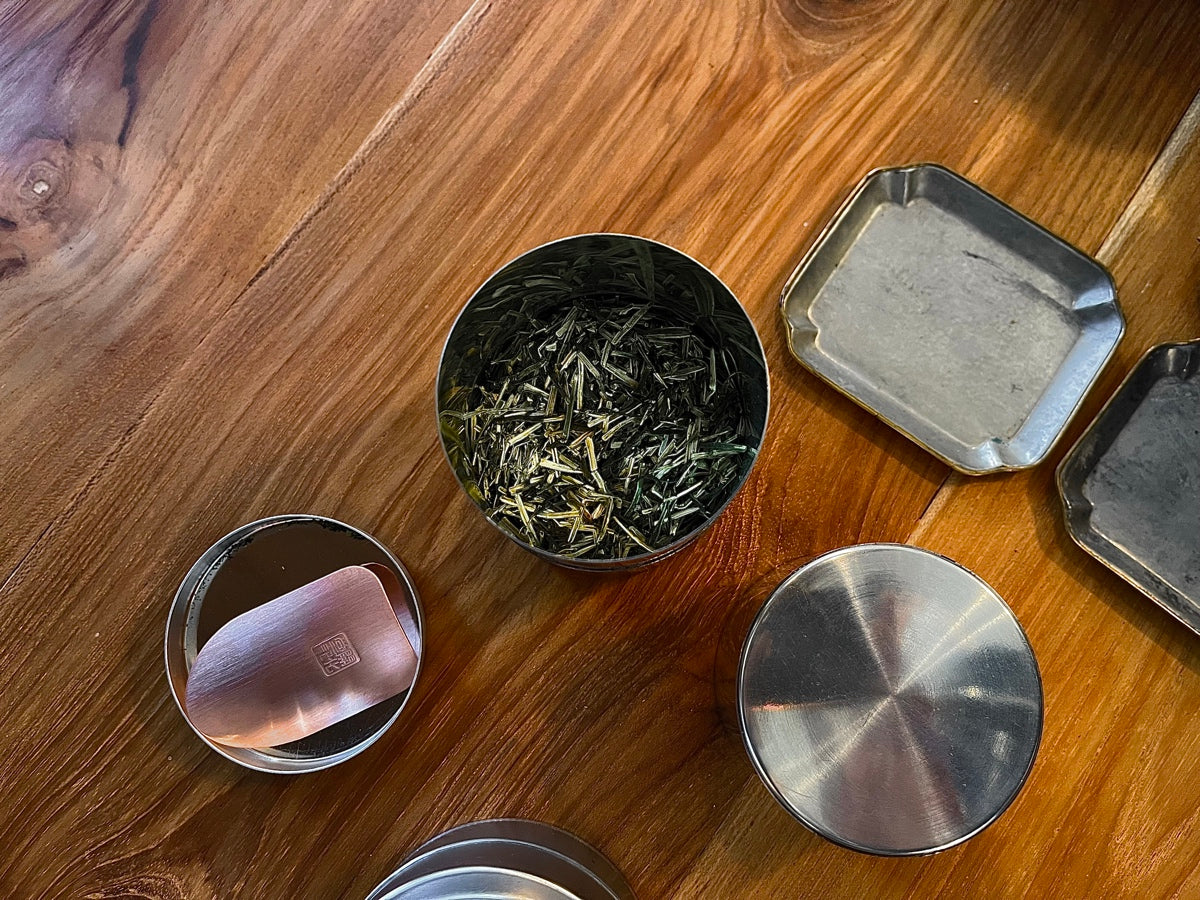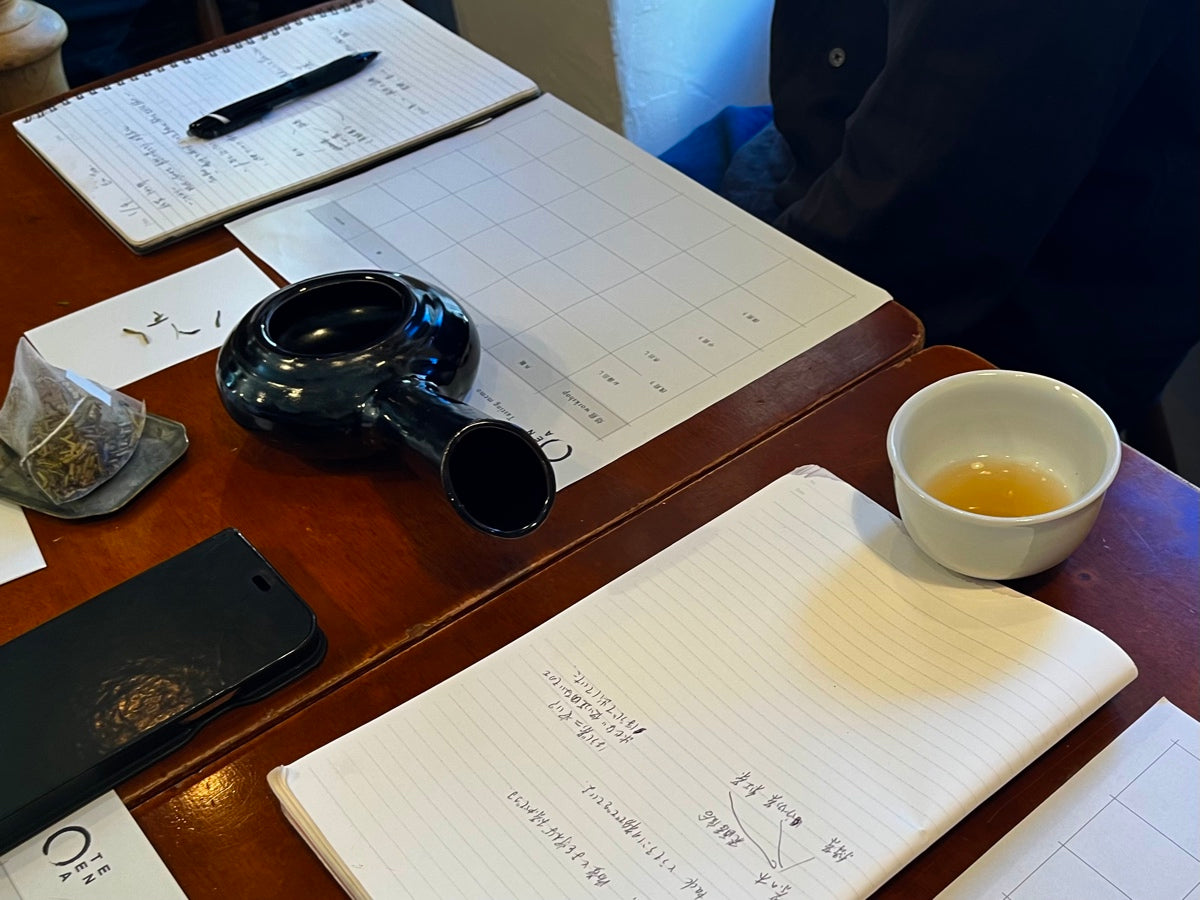[THEME] Possibility of "roasting"
A tea leaf shop pursuing the potential of Japanese tea [ GEN GEN AN illusion ]
Tea experiment discussion with professionals of various genres gathering around it " NEW TEA LAB ". The tenth time is at Sangenjaya uguisu And Nishiogikubo organ Chef who deals with Makoto Konno We visited him and talked about the possibilities of tea through a roasted tea workshop.

The act of "roasting"
The famous store "uguisu", which stands quietly in a corner of Sangenjaya, Tokyo, and the popular bistro "organ", which represents Nishi-Ogikubo. Both are French restaurants that offer beautiful and delicious dishes made with carefully selected natural wines and carefully selected ingredients. What kind of change will the existence of "tea" change in the hands of chef Makoto Konno, who handles these two stores? What kind of efforts can be made using "tea"? With such curiosity in my heart, I held a workshop focusing on "roasted tea" in order to explore the possibilities of "tea"."Hojicha Workshop" where you can taste the three types of light roast, medium roast, and deep roast, and the tea bags of the products with water. The tea master Nobe of EN TEA roasts the tea leaves on the spot by putting the roasting that Higashiya and GEN GEN AN phantom co-produced on an open flame. While shaking the roasting finely, identify the moment when the smoke comes out, and adjust the roasting condition while watching the color. When the fluffy white smoke rose, the inside of the store where the preparation was made was immediately surrounded by the scent of roasted tea.
"Green tea, oolong tea, black tea. There are various types of tea. These are all made of the same tea tree. One axis for changing the type is the difference in the degree of fermentation. Increasing the degree of fermentation of green tea leads to oolong tea. When it becomes more fermented, it changes to black tea. Another axis is roasting. Roasting tea leaves creates a different taste and aroma. There is also a degree of roasting. The combination of fermentation and roasting is endless. I feel that is the interesting part of tea. "(Maruwaka)
If the so-called "Hare" tea in Japan is gyokuro or green tea, the roasted tea is, so to speak, "ke" tea. The theme of this workshop is the act of "roasting", which is one of the processes for making roasted tea, which is "ke" = "everyday" tea, and the taste of the tea produced from it.

"Cooking" and "roasting"
"The roasted tea in EN TEA's tea bags is delicate and has a green feel, which is very good, isn't it?" The staff of uguisu, including Mr. Konno, are watching the roasting process with great interest."It changes completely depending on the strength of the fire. If the fire is too strong, even if the surroundings change color, the inside may not be cooked. It may be burnt. Often here in cooking! Because it is possible to make fine adjustments for a long time, we sometimes take the method of low-temperature cooking, but roasting is done at once with an open flame. "(Mr. Konno)
"The swelling increases by roasting the stem part and applying heat. It is a proof that the swelling and fragrant aroma of roasted tea are attached when steam and smoke rise. It is more transparent to roast in a short time. On the contrary, if you roast slowly for a long time, the inside feels bluish and the miscellaneous taste remains strong. This has not been verified in terms of ingredients yet. "(EN TEA) Development staff, Nobe)
First of all, eat freshly made lightly roasted roasted tea.
"Honestly, this is my first taste. I want to drink a little more (laughs). I have eaten roasted tea called light roast, but at first the roasted fluffy aroma comes out and the part after drinking is a little slimy. It's chilly. It's slimy or mellow. But it's green. The slimy part is transparent. "Mr. Konno is looking at the cup after drinking mysteriously.
"When brewed in an iron kettle, the horns are removed and it becomes thicker. It also has a more mellow taste. It changes again when the bowl is warmed. When it is made into ice cream, the taste and color also change and it is clear and delicious. What kind of water The interesting thing about tea is that the taste changes depending on whether you use it, what kind of tea it is brewed, and the temperature. "(Maruwaka)
After light roasting, go to medium roasting and deep roasting. Time goes by soaking in the world of roasted tea. The tea leaves are shaken in the roasting and roasted while emitting white smoke.

"When it comes to medium roasting, there aren't many places that go into it too much. The control between roasting conditions is very delicate, but we think that's what makes the experiment worthwhile.
These attempts are always trial and error, but what makes it possible is the combination of the development team's abundant experience and technical capabilities, as well as young sensibilities. (Maruwaka)
"(Medium roasting compared to light roasting) has a crisp outline of aroma and taste. There is a difference that you can't think of the same tea leaves. Deep roasting has a bulge in the tea leaves themselves and is fluffy. I also feel the sweetness "(Mr. Konno)
There are various possibilities for one roasted tea using the same tea leaves. A balance of changes in the appearance, taste, and aroma of tea leaves, aftertaste, umami, and astringency. "There is no such thing as a failure in brewing tea. In addition, roasted tea is stronger than green tea, so it is difficult for extraction to fail," says Maruwaka.
"It's a once-in-a-lifetime meeting. It's a taste that has an impact that Mr. Konno also felt, so light roasting is very attractive and memorable. If you stick to the variety, the possibilities will expand further. By the way, EN TEA's tea bags , Lighter roast than medium roast. "(Maruwaka)

(From the left, light roasted, medium roasted, deep roasted tea leaves)
The world of roasted tea that feels "new"
What happens when you actually "roast" rather than just drink? I was challenged.Put 2.5g of tea leaves in a roast and heat. When roasting while shaking the roasting finely, smoke suddenly comes out and the voice "Oh" rises. Look at the color of the tea leaves and keep them away from the heat, and put out the finished tea leaves from the bottom of the roasted tea. Experience the act of "roasting" while talking with everyone "Is it burnt?" "There is unevenness."

"Even if the roast is uneven, you can drink it deliciously as a personality" (Nobe)
While eating the tea that he had roasted himself, it leaked from Mr. Konno's mouth. "Very interesting"
"This was my first experience, but it's very close to the world of coffee and wine. The impact of the first light roast was amazing. It feels like the first time I drank third wave coffee or natural wine. I was surprised at how delicious this is because it was a taste I had never experienced before. What about this balance? For the past 10 years or so, in the world of natural wine. The trend is for so-called "light horses" that are lighter in extraction, but there are times when I think that "light horses" alone are not interesting. Similarly, in light roasting, you can feel the nuances of tea leaves straight, but by roasting, you can feel the possibility of bringing out the new charm of tea leaves. "(Mr. Konno)
Some wines in bottles are on the market as a finished product. Unlike that, tea leaves have an aspect as a "material".
"High-quality tea can be arranged after it is made. That is both mass and professional. What should I do today?" (Maruwaka)
"I've always wanted to use tea (as a material). Whether it's tea or wine, I think it's important to respect what the producers make and put it into a delicious form. In my case, I'm going to do a mess. I think I'll do it with something! In the case of wine, it seems like it lacks respect for the producer. But ... For example, if you use tea, you don't use animal-based ones, but those that contain a lot of umami ingredients, such as tomatoes that have been strained with a mixer and then added with roasted tea to make a clear soup. I think we can make something like that. The tannins and aroma of tea are added to make it delicious and cool. It seems to go well with dessert. "(Mr. Konno)
"Please play hard. I'd be happy if you could add it to the palette like spices as a material." (Maruwaka)
The ideal way of "tea leaves" as a material that is the basis of cooking ideas. That is the ideal form of tea for EN TEA. A new "beautiful taste" that cannot be achieved by pursuing only at the teahouse. Experiments that expand the possibilities of tea will begin again from here.

Edit & Text: Kana Takeyama ( PARK 365 )
